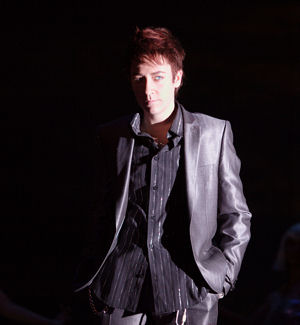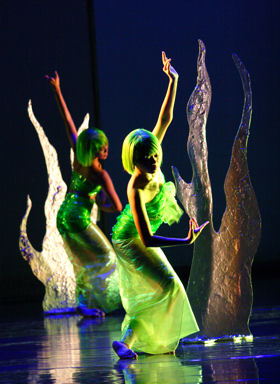Other Links
Editorial Board
- Editor - Bill Kenny
- London Editor-Melanie Eskenazi
- Founder - Len Mullenger
Google Site Search
SEEN AND HEARD
OPERA REVIEW
Monteverdi, The Coronation of Poppea:
(new production)
Soloists, continuo and musicians of English National
Opera, conducted from the harpsichord by Laurence
Cummings, Chen Shi-Zheng (director), Walt Spangler
(set designer), Elizabeth Caitlin Ward (costumes),
Mimi Jordan Sherin (lighting designer), London
Coliseum. 18.10.2007 (JPr)

Anna Grevelius - Nerone
Monteverdi's importance in the history of Renaissance
music is equivalent to that of Shakespeare's
on literature. He transformed every genre in which he
worked by constructive use of available styles rather
than by revolutionary means. His madrigals cover a
period of 40 years and introduced instrumental
accompaniment and chromatic modulations,
so that the dramatic nature
of his music
became the forerunner of the
solo cantata and operatic recitative.
The sacred music involved
everything from traditional
elaborate polyphony to an advanced style where
elements from the
secular madrigals and operas lend colour and drama to
the text, as in the famous 1610 Vespers. The
operas embellish Florentine melodramas and
monody to provide a drama with words underwritten by
the music.
They are the first music dramas with leitmotif
elements and characters who
are recognisable as real human beings rather than
as the symbolic form of
mythological creatures. Much of the text is scored in
recitative-musical speech by means of virtuoso vocal
writing and there is rarely any repetition or ‘arias’
as we now know them. Monteverdi often makes the music
match the words so that if
thoughts are turning
to heaven then the musical line ascends:
when it turns to passion you hear a musical
heartbeat. This genius for
melody and harmony makes the
music accessible and even the text of something like
The Coronation of Poppea, one of three operas
composed in the final years of a remarkably long life,
can have much to say about
today’s world dealing as it does with vanity, greed
and ambition.
The music is so subtle
that even today we
can be made to wonder
how people like Poppea
and Nerone (Nero) can be celebrated with a ravishing
duet and a celebratory happy ending.
A certain irony
is being expressed here
because we know - and Monteverdi and his audience
certainly did – what became of the real Nero as well
as how he had a hand (or rather a foot – she was
kicked in the stomach) in the death of his pregnant
Poppea only three years after their marriage. As opera
moved from the ducal palaces to public theatres in the
1640s, so Monteverdi’s
patrons in Venice in 1643 knew they were watching just
a flashback of times gone by where Virtue did not
always win out and Fortune and Love were fickle (these
three allegorical characters inhabit the Prologue.)
They understood the relevance of the drama's
lack of moral compass and political ambivalence
to the independent Carnival-engorged Venetian republic
standing proud between the Italians courts and the
pope in Rome. In the opera the ‘good’ (such as they
are) are sent into exile or commit suicide, while the
‘bad’ are victorious.

Kate Royal - Poppea
The early music specialist Laurence Cummings conducted
a small period band from the
harpsichord and has commented on the
authenticity of the opera, the performing version used
and the orchestra as follows: ‘Much ink has been spilt
on the subject of how much of the opera is actually by
Monteverdi. In fact, that issue doesn't bother me. We
spend so much of our time as historical performance
specialists trying to get as close to the original
text and the composer's intentions as we possibly can,
that it's quite liberating to feel that
we're playing a work that's by many hands. I like to
think of it as being similar to how painters had a
whole workshop of apprentices helping out. It frees
you up to take a few liberties where you might not
normally be able to. For instance, I've added
trumpets, which aren't in the original score, to
augment the coronation. I'm almost entirely convinced
that a lot of the ritornelli are not written by
Monteverdi, because there are two versions of the
manuscript, one from Venice and one from Naples. In
some ways Venice is closer, because that's where it
was first performed, but there are lots of mistakes.
The Naples score was at more of a distance, and it has
totally different violin parts. What's clear is that
the bass line was written down and then the other
parts were added on top. So I've amplified it by
giving it a five-part texture, which all the string
parts in Orfeo and The Return of Ulysses
have.
'It serves us very well because the Coliseum is a
large place to fill. Therefore we've chosen to use
eight violins, six violas and two cellos. It's not a
big orchestra, but it's bigger than it might be. I've
added the trumpets because the music for the
coronation is redolent of trumpets in any case – I
think that the original probably meant to indicate
violins imitating trumpets – so I thought, why not
have the real thing? Once you've realised that the
(original) two violin parts aren't by Monteverdi
anyway, it frees you up to make this kind of small
liberty. The audience is waiting a long time for the
coronation to happen – they sit through the whole
opera before it happens, and it's actually quite a
quick scene. So I think it really needs to burst
through and make a huge impact.'
This small orchestra made a surprisingly large sound
but never swamped the singers so that
the vocal line was always
supported – as it should be – by the music and
came through with absolute clarity making the ENO’s
surtitles for operas in English extremely redundant.

The Orange Blossom Dance Company
One would have thought English National Opera the
ideal place to update this work and bring the
production into the twenty-first century as a mirror
to reflect vaulting ambition and triumph of evil over
good as it exists in the world today. Unfortunately,
director Chen Shi-Zheng gave us a fairly
vacuous fashion show concept with colourful couture
(by Elizabeth Caitlin Ward) for the women (and
the travesti role
men) with a concomitant
video display on the back wall. This might have
reflected the commentary on the ‘vainglorious’ in
Monteverdi’s opera but it
did little else for me. The
men were in urban
street gear or suits.
Walt Spangler’s set design gave us a basically bare
stage apart from stage right the prow of a yacht
which doubled as a gang
plank in Part II. We were apparently at the bottom of
the sea. Poppea (or rather her ‘flying double’) goes
‘swimming’ with snorkel and flippers and a fetching
bikini. Ottavia is pushed around the stage on what
could be an inflated sea anemone and Seneca commits
suicide among cut-out kelp fronds. Cue appropriate
undersea flora and fauna displayed on video in black
and white!
Saying that Ottavia is
‘pushed around’ brings me to Shi-Zheng’s use of
dancers from the Indonesia-based Orange Blossom Dance
Company whose role (apart
from moving pieces of the set)
involved representing catwalk models or flunkies as
well as traditional
(?) dance movements. More often than not
-they were a distraction to
the singing in Part I, most
notably while they gyrated during the closing Nerone/Lucano
(Nicholas Watts) duet. The production was much better
when the dancers were absent
for much of the second half.
Fortune (in purple plastic), Virtue (in green) and
Love (in red) opened the proceedings
and gave warning of what was to follow (in more ways
than one). They were respectively Katherine Manley
(the least comfortable with the style), Jane
Harrington and Sophie Bevan. Throughout the evening
after understandable first night nerves,
all the voices settled down and sounded well-rehearsed
and all the minor roles were particularly
well cast.
Lucy Crowe’s dizzy blonde,
slightly unfairly treated
Drusilla was a delight making all her words count with
an easy pure soprano. Ottavia, the vengeance seeking
spurned wife of Nerone, was sung with a well-tuned
sense of drama by Doreen Curran. In among
so many young promising singers Robert Lloyd as
Seneca brought a touch of the ‘old school’ through his
pointed enunciation of the text and a resonant bass
that reverberated around the Coliseum.
I enjoyed Christopher Gillett in the ‘travesti’ role
of Arnalta, Poppea’s silly old nurse. The opera
provides him (her?) with many wonderfully comic
moments and gave a light touch to the proceedings
again in Part II. Her pompous monologue about wanting
to be reborn a Lady (instead of a servant) includes
one of the more intriguing rhymes in Christopher
Cowell’s occasionally anachronistic translation -
‘hoi polloi’ and ‘hey, oy’.
Most important of course is the triumvirate (Ottone,
Poppea and Nerone) at the centre of this operatic
triangle of love, ambition and power. Tim Mead sang
Ottone with a countertenor tone that was not too
pleasant on the ear at first but tuned up by the time
he was centre-stage in Part II : then
he sounded his most eloquent
and at ease. Unfortunately,
his character never ventured further than a love-sick
puppy who is spurned by his amorata (Poppea) and is
urged to attempt to kill her.
Poppea is all for the status that
being empress will give her and if Monteverdi
has any sympathy for her, it does not show. She is a
soul driven by her ambition to be the most powerful
women in the land and uses all her ‘charms’ to get
what she wants from Nerone. Kate Royal has the
visible charms needed
and an expressive sultry
soprano voice that made me think of the
Carmen to which she
will undoubtedly bring her qualities sometime.
If there was any doubt in this
Nerone’s mind, it could only have been how long
it would take to win over Poppea. Anna Grevelius seems
an accomplished dramatic singer who brought
home the qualities of a
lover well enough with some beautiful soft top notes
but with little of the
despot wielding power with ruthless abandon. I
believe the role was originally intended for a high
male voice but exponents are
rare these days. With two female voices,
it does unbalance the moments
between her Nerone and
Poppea, as well as Seneca just a bit.
Here, Nerone was
arrogant and Poppea beautiful and scheming and that
was the extent of their characters who failed to
complete any ‘journey’ during the opera beginning the
evening as they exactly as they ended it. Perhaps that
was Monteverdi’s fault – perhaps Shi-Zheng’s?
A final tableau with the dancers as silver dragonflies
- some suspended above the
stage - provided
a sublime conclusion to the evening though what it
had to do with the ‘coronation’ or the original
undersea world concept, I
couldn't imagine. Perhaps
that thought sums up a
harmless – if rather too long - evening with some
beautiful music and singing.
Jim Pritchard
Pictures © Catherine Ashmore / English
National Opera
